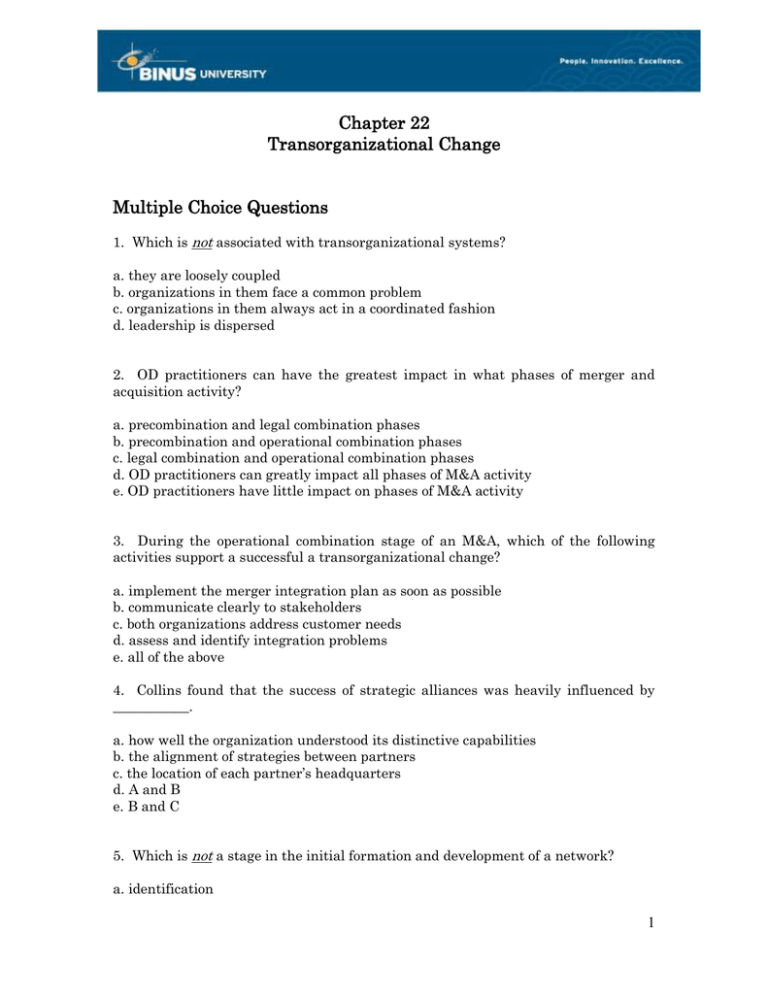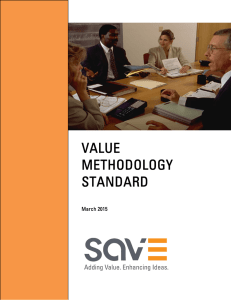Chapter 22 Transorganizational Change Multiple Choice Questions
advertisement

Chapter 22 Transorganizational Change Multiple Choice Questions 1. Which is not associated with transorganizational systems? a. they are loosely coupled b. organizations in them face a common problem c. organizations in them always act in a coordinated fashion d. leadership is dispersed 2. OD practitioners can have the greatest impact in what phases of merger and acquisition activity? a. precombination and legal combination phases b. precombination and operational combination phases c. legal combination and operational combination phases d. OD practitioners can greatly impact all phases of M&A activity e. OD practitioners have little impact on phases of M&A activity 3. During the operational combination stage of an M&A, which of the following activities support a successful a transorganizational change? a. implement the merger integration plan as soon as possible b. communicate clearly to stakeholders c. both organizations address customer needs d. assess and identify integration problems e. all of the above 4. Collins found that the success of strategic alliances was heavily influenced by ___________. a. how well the organization understood its distinctive capabilities b. the alignment of strategies between partners c. the location of each partner’s headquarters d. A and B e. B and C 5. Which is not a stage in the initial formation and development of a network? a. identification 1 b. action c. convention d. organization e. evaluation 6. In the identification stage of creating a network, which of the following activities do OD practitioners participate? a. take an activist role in choosing potential members b. survey the political realities of the new network c. clarify the goals, products & technology exchanges of the network organizations d. A and C e. all of the above 7. The last stage in managing network change is: a. create instability in the network b. convention of the organizations in the network c. relying on self-organization d. managing the “tipping point” in network change e. letting mavens talk about the change 8. Instability within a network organization is most influenced by ____________. a. Network members performing their agreed-upon roles. b. Regular communication between network members. c. Network members who display “agency” d. OD practitioners interventions. e. C and D 9. Three key roles help to explain how change within an existing network occurs. They are: a. leaders, salesmen, and managers b. executives, mavens, and informal leaders c. salesmen, mavens, and connectors d. mavens, connectors, and executives e. connectors, leaders, and influencers True/False Questions 10. In the initial establishment of a network, potential members are identified in the convention stage. 2 9. Because transorganization systems are composed of multiple organizations, the change agent needs to treat each organization differently. 12. A good alliance partnership will leverage both similarities and differences to create competitive advantage. 13. The relational quality of alliances benefits from OD interventions aimed at increasing trust. 14. Operational combination activities should proceed slowly and carefully following the announcement of the merger or acquisition. 15. Team building and other human process interventions can play important roles in merger and acquisition integration. 16. During the convention stage of network formation, OD practitioners should remain neutral, treating all members alike. Essay Questions 17. Describe the major phases of merger and acquisition activity and discuss how OD practitioners can contribute to successful integration. 18. What is the role of the change agent in transorganizational development? 19. How can OD practitioners help two organizations build trust between them? 20. How can OD practitioners assist network organizations to rely on selforganization? 3



